- HOME
- Marketing
- Developing a Powerful Brand Positioning Strategy
- Strategies for Differentiating Your Brand
Strategies for Differentiating Your Brand
- 13 Mins Read
- Posted on December 6, 2018
- Last Updated on October 8, 2024
- By Lauren
If you’ve been following along on our brand positioning journey, by now you’ve taken stock of how your business is currently perceived by your market; you’ve discerned how your competitors are positioned; and you’ve done some visual mapping to discover where you do (or could) shine relative to your competition.
Drawing on those insights, it’s time to start narrowing that focus down to a single, unique positioning idea. This will be the one word or concept that sets your business apart from your competition. It will be the primary value you offer your market… though hopefully, you’ll offer them many secondary forms of value.
You’ve done all this research on your competitors so you can compete on attributes that they’ve either failed to serve or simply don’t talk about. (Let’s say you’re a company that makes thermoses, for example, and research has alerted you to the fact that your competition isn’t delivering on products that keep their contents hot for more than a few hours. This is where your “Same Temperature… All Day” promise could become a major differentiator.)
Remember: Don’t just choose an attribute to highlight because it’s never been highlighted before. Your differentiator must be more than unique; it must be 1) relevant to your target market; and 2) something your company is capable of delivering. You may discover your differentiator through market research (“9 out of 10 clients have praised our flexibility”), or it may be a specialty you’ve intentionally cultivated (“we provide specialized legal services specifically to the hospitality industry”).
If you’ve done any research on brand differentiation, you’ve probably come across any number of listicles that summarizestrategies, with few examples of what those strategies actually look like. As a result, you may still be wondering how “differentiation” works in the real world.
So below, we’ll discuss some competitive positioning styles alongwith instances of those styles at work. Keep in mind that these aren’t the only ways to highlight your competitive advantage and the value you offer your market. If one of the below styles resonates for you, great! If not, don’t try to pigeonhole yourself into what’s below. Get creative and think outside the box. Maybe you’ll come up with a hybrid of what’s below. Or maybe you’ll invent a different strategy altogether.
Product-driven Positioning
We’ll start here because this is the most traditional strategy. It’s also the most visible, insofar as it involves highlighting the attributes of a company’s product or service. There are many types of product positioning. Differentiation can focus on any number of factors, including:
Product characteristics or features
When Tesla entered the electric vehicle market—a market owned by Toyota Prius and Chevy Volt—it brought a luxury sports option to a market that had been competing on battery power. Tesla turned that market—which valued economy over aesthetic—on its head when it positioned itself as prioritizing the latter. Or think Chickapea, which makes organic pasta made of just two ingredients: chickpeas and red lentils. (It also happens to be gluten-free, vegan, and kosher… including their mac and cheese.) No one else in the pasta market is doing this; and they make sure to emphasize this distinction in their copy (the “new” guilt-free choice that’s “not just better for you,” but “good for you”):
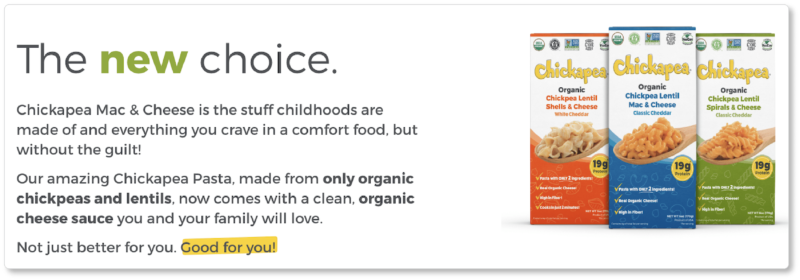 If your company offers a product or service that’s “the only one if its kind,” then you may be a good candidate for this positioning strategy.
If your company offers a product or service that’s “the only one if its kind,” then you may be a good candidate for this positioning strategy.
Product benefits
It may be worth recalling the difference between features and benefits here. Features refer to characteristics of the offering itself: functionality or technical details, for example. Benefits, on the other hand, are what customers experience as a result of those features. While features focus on the product, benefits focus on the consumer—essentially answering the question “What’s in it for me?” from a prospect’s point of view.
M&Ms won “the most liked advertising slogan” a few years back with its “melts in your mouth, not in your hands” promise—a slogan the company has had since 1954. The story goes that, after Forrest Mars, Sr. saw soldiers eating chocolate encased in a coating during the Spanish Civil War, the maker of Milky Way determined to create something similar when he returned home… which he did, patenting the hard sugar coating we’ve all come to know and love. During World War II, M&Ms exploded in popularity thanks to the number of consumers in the U.S. army alone. (The candy could be included in soldiers’ combat rations because the coating allowed them to withstand high temperatures.) While it was a favorite with GIs, the characteristic was unique—and relevant—enough to resonate with civilians as well.
But notice that M&M’s didn’t tout their “patented sugar coating” in their ads: Though this was a differentiating factor, it was a feature; not a benefit. The benefit was (and is) that consumers got to satisfy their sweet tooth while on the move and in the heat… without the mess that most chocolate products produce.
Product design and aesthetics
Nest thermostats are a great example of this positioning strategy:
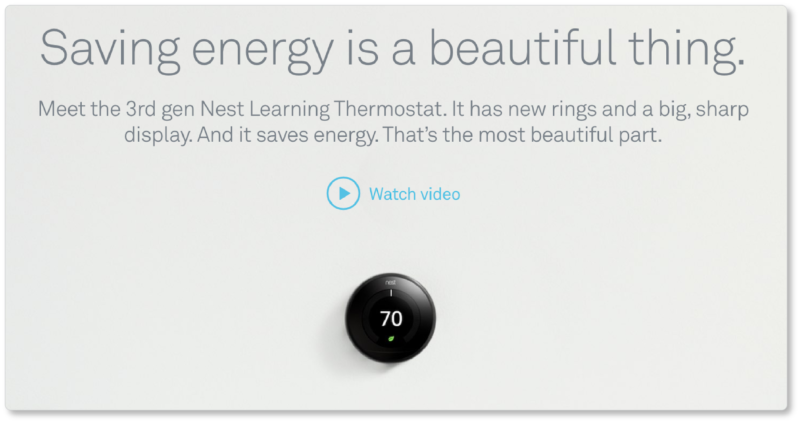 Nest differentiated their product by abandoning the traditional, off-white, square-ish thermostat, and opting for a sleek black (or white) round version. The word “beautiful” in the product’s tagline (“Saving energy is a beautiful thing”) cleverly has a dual significance: It qualifies both the aesthetically-pleasing product itself, and its sustainable impact.
Nest differentiated their product by abandoning the traditional, off-white, square-ish thermostat, and opting for a sleek black (or white) round version. The word “beautiful” in the product’s tagline (“Saving energy is a beautiful thing”) cleverly has a dual significance: It qualifies both the aesthetically-pleasing product itself, and its sustainable impact.
Product quality, performance, or reliability
This type of positioning is used by businesses who consider themselves “luxury,” “premium,” or “the best” in a particular category. (Think BMW’s “ultimate driving machine.”) Duracell has positioned itself as a battery with longer life than any other option out there: “10 times longer,” in fact. It’s a nice round number—not to mention an impressive one—and therefore difficult to forget. The company cites their differentiator with remarkable consistency: on their website, on their packaging, in their ads. They also back up their claim by citing the testing conditions under which it was proven. (That’s a signal for customer trust, by the way):

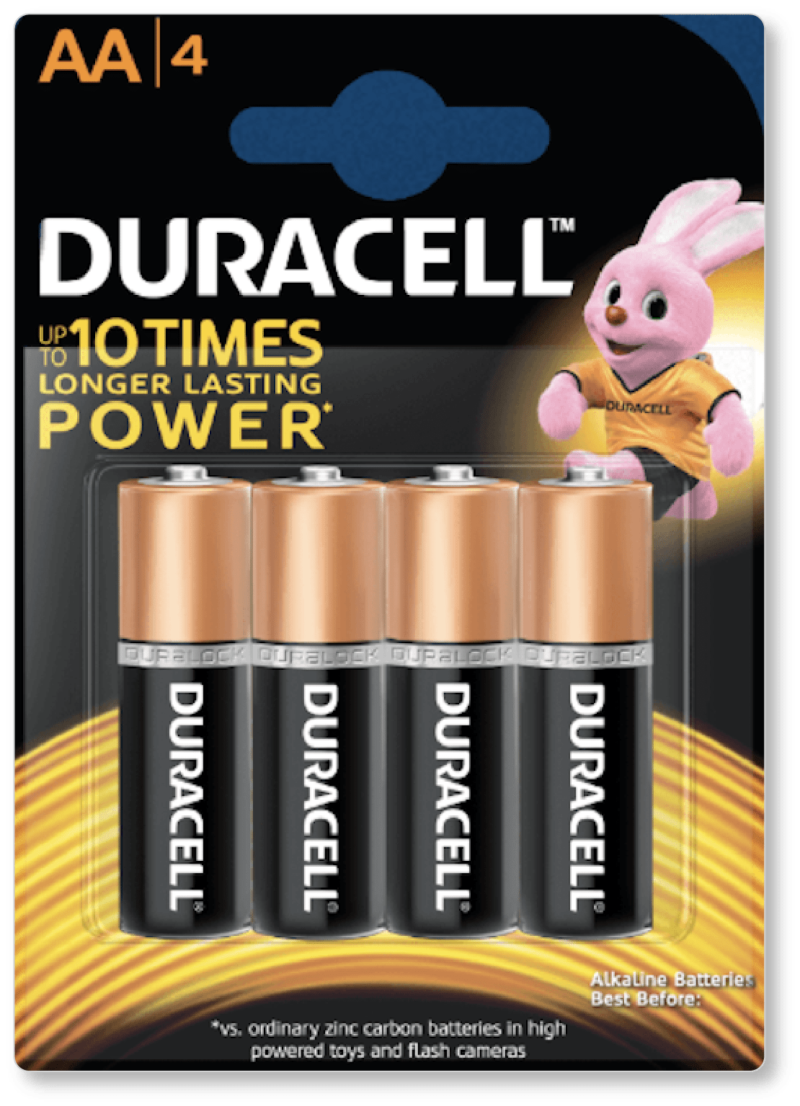
In this strategy in particular (though it could certainly be said of the other strategies we’ve mentioned), price is secondary to the benefits obtained from using the brand. Remember: There’s an assumed—and direct—correlation between price and quality in every market. You’ll want to reflect that correlation in your pricing if you opt for this strategy.
Product origin
French wine, Italian leather, Berber rugs… some product campaigns have been so successful that we automatically associate a product with a region (or a people) now. Raw materials could certainly fall under the “origin” category: Consider, for example, the recent trend for wooden eyeglasses. So does geography.
The coffee industry exemplifies this latter strategy. Kona Coffee and Tea prides themselves on their “100% Kona coffee” which is “grown on the slopes of Hualalai, then milled, roasted, brewed, and served all within a 10-mile radius from our farm”—a claim we’re betting no other coffee company can make:
 Product price
Product price
When it comes to product price, you could differentiate in any direction. Perhaps you’re in a position (due to low production costs, for example) to become the Walmart of your industry. On the other hand, maybe you’ve decided to offer your product at a higher price than your competitors because—as we’ve mentioned—consumers will equate that price with higher quality.
Take L’Oréal, who entered the hair dye market in 1973 with a more expensive product than any of their competitors’ products. The company marketed their position brilliantly, with the affirmation “Because I’m worth it”:
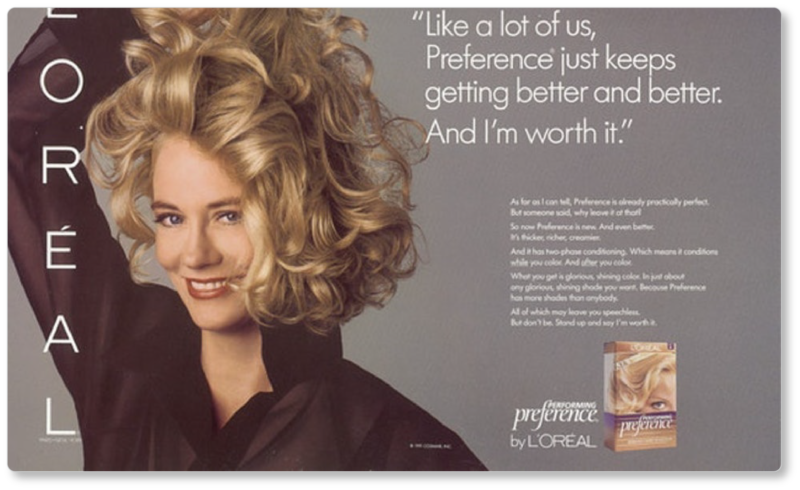 45 years later, the company’s position hasn’t changed… though their current “Women of Worth” campaign redefines the word “worth” as it was used in L’Oréal’s earliest marketing messages:
45 years later, the company’s position hasn’t changed… though their current “Women of Worth” campaign redefines the word “worth” as it was used in L’Oréal’s earliest marketing messages:
 Of course, these aren’t the only product differentiators out there. Maybe after doing your research, you’ve discovered that your product beats your competitors’ products in the areas of:
Of course, these aren’t the only product differentiators out there. Maybe after doing your research, you’ve discovered that your product beats your competitors’ products in the areas of:
- ease of use
- variety
- privacy
- sustainability
- health
- use or application
- manufacturing process
… or any number of other things.
That said, we’d suggest that—rather than jumping directly into this strategy—you consider all your options. And here’s why:
Product positioning strategies only work in the long-term if your product or service is nearly impossible to replicate. Features and innovations are typically easy to copy; and—thanks to globalization—there’s a good chance that at some point, similar products will be launched at lower prices than yours. Of course, that’s not to say you shouldn’t differentiate your product… you just shouldn’t rely wholly on that difference to maintain your competitive advantage.
Service-driven Positioning
Differentiating your brand at the level of service means everything from ease of purchase, to on-time (or early) delivery, to employee knowledge and experience, to customer service, installation, personalization, after-purchase care… and any other customer-facing interactions your business has. With service-driven positioning, you’ll focus as much on your employees as on your customers: Every one of them will have to demonstrate courtesy, competence, receptivity, credibility, and dependability at all times. If market research has shown that your prospects are disappointed by your competitors’ service, this might be a strategy for you… but know that you’ll need a superb, highly trained, and well-cared for team.
The online retailer Zappos’ tagline is “Powered by Service”; and they’ve proven themselves again and again in this arena. Maybe you’ll remember this story about Zaz Lamarr, a Zappos customer who was in the middle of a product return when her mother died:
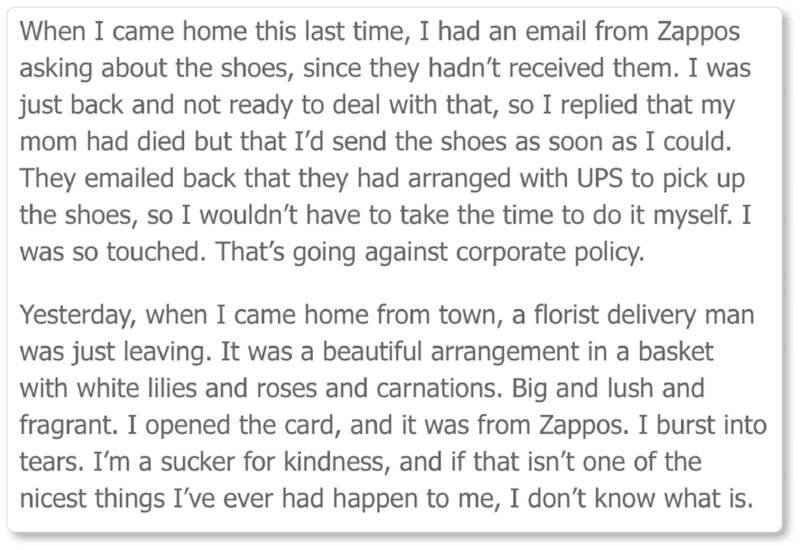
Zappos doesn’t have to compete on price; their customer loyalty is sky-high thanks to experiences with the company such as Zaz’s. If your competitors haven’t already staked this position, it may be a strategy worth considering.
Process-driven Positioning
Process-driven positioning often looks a lot like service-driven positioning. The point is that there’s something unique and bespoke in the business’ internal processes that allows for better delivery—even though the product may be very similar to the competitions’. (Think FedEx’s “When it absolutely, positively needs to be there overnight.”)
Of course, “process” doesn’t necessarily mean prioritizing speed. Consider Burger King’s “Have it Your Way” tagline. The fast food chain positioned itself in direct opposition to McDonald’s, which had introduced the fast food category in 1948 by applying production-line principles to burger assembly. While this allowed for speed, it led to a certain rigidity: Customers couldn’t place special orders. Burger King recognized and leveraged this weakness. They figured out how to co-opt the assembly line strategy while accommodating special orders. McDonalds may have already owned “speed”; but Burger King could own “flexibility”:
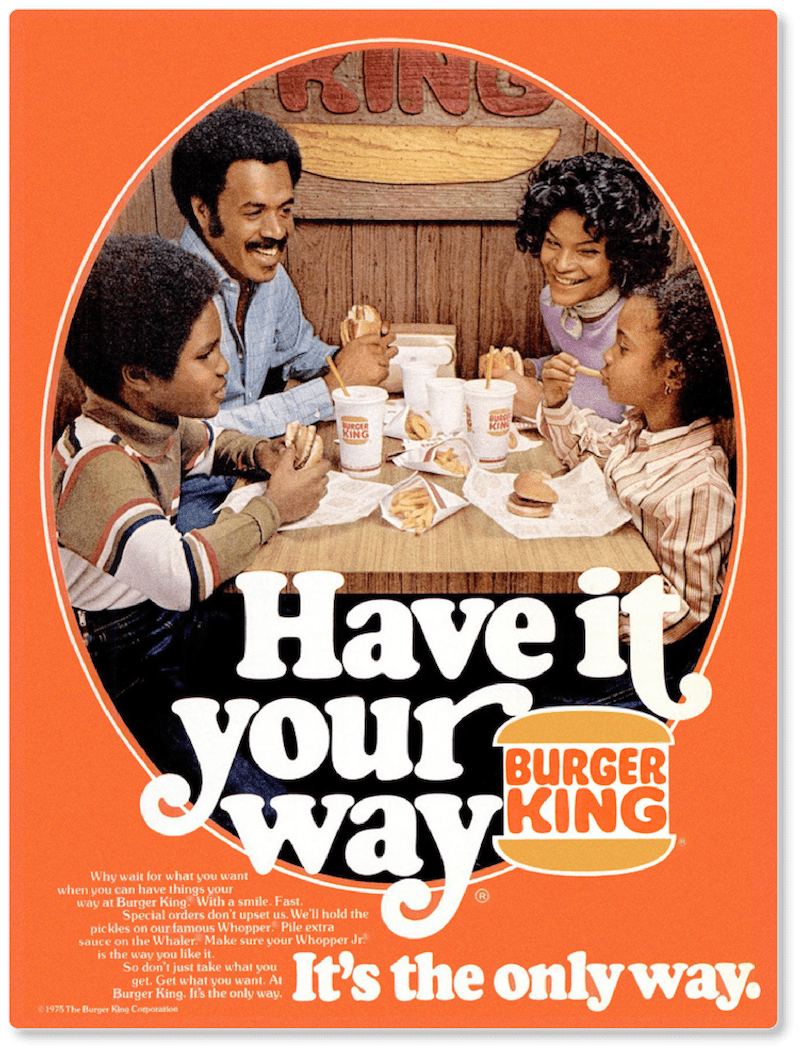
Values-driven Positioning
As we’ve mentioned, relying purely on product quality leaves you open to being undermined by the next competitor who can make your product better, faster, or less expensively. Values, on the other hand, are difficult to replicate. We probably don’t have to tell you that customers don’t always choose the businesses they work with because of their product features. They often choose them because the company’s worldview resonates with their own.
This is a terrific strategy to employ if you find that your competitors are answering their “what” but failing to answer their “why”… or if you realize that your “why” is different from theirs. Why are you committed to this offering in this industry? Why do you care about this aspect of your target market’s lives? Values-driven positioning pulls at heart-strings… if you can’t be the “best,” “fastest,” or “foremost” (and few businesses can), you can find your strength in emotional differentiation.
Since we’re already talking fast food, consider Chipotle’s decision to position itself relative to Taco Bell. Both restaurant chains fall into the Mexican fast food category. But when Chipotle entered the market, they decided not to compete on speed or price. Instead, they positioned themselves as defenders of food ethics. The company’s tagline promises “Food with Integrity,” and its messaging includes a short film called “The Scarecrow” that condemns agro-businesses and aligns Chipotle with small farms and fresh, unprocessed ingredients:

(You can also check out Chipotle’s inspiring 2011 “Back to the Start” ad, which helped boost the restaurant’s sales by over 23%. That’s some strong values-based positioning.)
Purpose-driven Positioning
Here’s another “why” category… but it focuses more on outcomes than values-driven positioning does. If you’re looking for good examples of purpose-driven positioning, we’d suggest jumping on the websites of your favorite non-profit organizations and examining how they’re positioning themselves. Charity: water’s summary of why they’ve chosen water is a brilliant example:

If you’re not a non-profit, your company’s purpose is no less valuable. Think JetBlue, which entered the airline market around the time that companies such as Delta were reducing legroom and cutting snacks to cut costs. JetBlue’s tagline is “You Above All,” which plays on the dual meaning of “above” (“before,” “overhead”). They touted their extensive legroom and gourmet snacks. And while they had neither an extensive frequent flier program nor international flights, they won loyalty for a strong, customer-driven purpose: airborne hospitality above “cost-cutting.”
Competitor-driven Positioning
We know: Your positioning will be “competitor-driven” no matter which strategy you choose. Your business doesn’t exist in a vacuum; and you’ll clarify your direct competitors when you decide whose weaknesses to leverage to highlight your strengths. This strategy is bolder, however, insofar as it speaks back to the market leader when it enters a market.
Consider 7-Up’s “The Uncola.” What was so brilliant about 7-Up’s positioning strategy is that it rode the wave of a counterculture in full force when the soft drink company entered the market. It was the late 1960s; the U.S. was divided by the civil rights movement and the Vietnam War. 1967’s “Summer of Love” brought anti-war, anti-establishment protesters together in cities around the country. 7-Up seized upon this energy, positioning its product as an “oppositional” beverage. The strategy struck a chord—and found a niche—in the soda market, by essentially repositioning Coke as an undesirable (“establishment”) product:
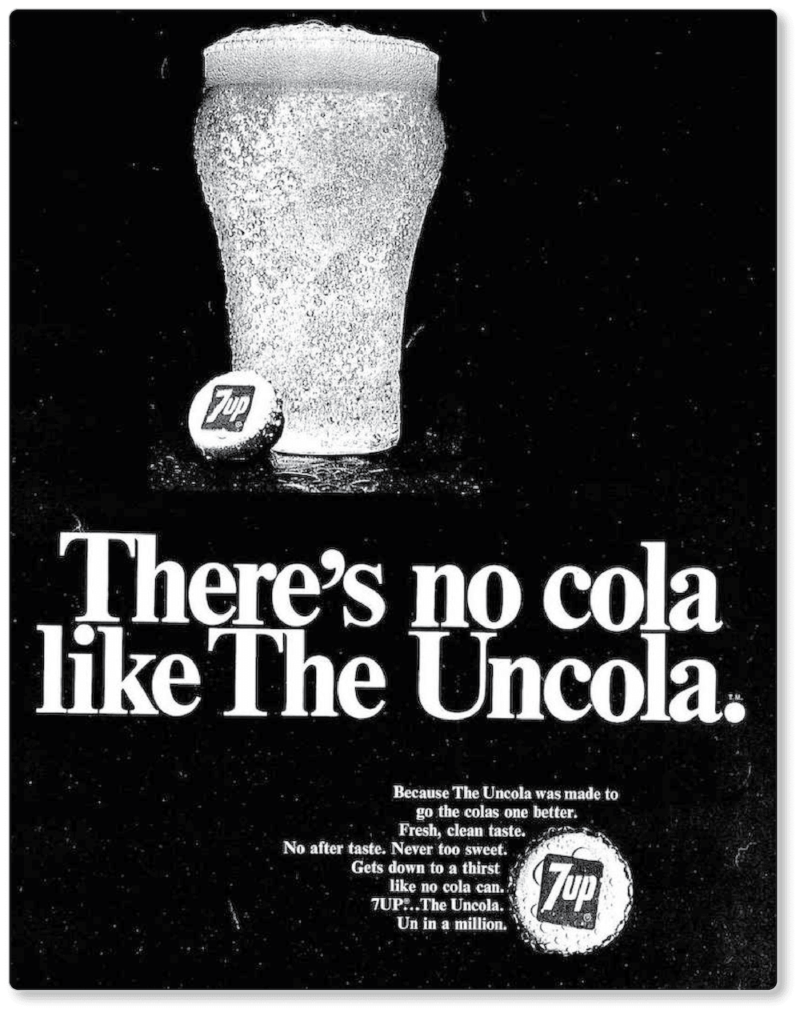
Of course, there are other ways to take up this strategy. Think Avis’ “When you’re only No. 2, you try harder”: a tagline that’s morphed over the years into the more simple “We try harder.” Avis had come to realize that it wasn’t going to outperform Hertz anytime soon. So the company wonderfully managed to make a virtue out of being second-best.
Niche-driven Positioning
One final strategy—indeed, perhaps one of the most powerful strategies—is to focus on a sub-segment of the market you’re in (or want to enter). You may decide to do this if you hear enough complaints from certain market segments about being underserved by existing market leaders. Then again, maybe your prospects don’t even realize they have needs that aren’t being met—in which case you’ll identify this gap yourself through market research.
If you can cater to an underserved niche market in your industry—and specialize in that need—go there. If you sell security equipment, maybe you work specifically with financial institutions. If you make breakfast cereal, maybe you position yourself for female endurance athletes. Vimeo used this strategy to focus on professional videographers while YouTube remained non-specific about its target market. Royal Caribbean targeted young adventurers in a market that had been targeting either honeymooners or retired people. The cruise ship company perceived an untapped segment, and ran with it to great success.
Lesser-known companies who’ve taken this approach include Four Quadrants (financial advisors who specialize in financial planning for dentists), Nerd Fitness (a “fitness academy” with private coaches that caters to gamers and grad students rather than jocks), and Drybar (a hair salon that doesn’t do cuts or color; it only does blowouts). You’ll see how Drybar claims its niche on its website:
 What makes this strategy so powerful is that when you offer specialized expertise, your market perceives you as being deeply attuned to—indeed, one step ahead of—their needs. So if you choose this strategy, be absolutely clear about your customer persona—you’ll want to be inside their heads at all times.
What makes this strategy so powerful is that when you offer specialized expertise, your market perceives you as being deeply attuned to—indeed, one step ahead of—their needs. So if you choose this strategy, be absolutely clear about your customer persona—you’ll want to be inside their heads at all times.
Again, the above strategies aren’t your only options. In many cases, what drives your positioning will depend on your industry: A distribution-driven positioning strategy, for instance, might be used by a cell phone carrier (think coverage); while an infrastructure-driven strategy might be used by a business that offers mobile services in an industry whose players don’t have the resources to offer that yet (mobile bike repair for long-distance bikers, anyone?). You know your industry better than we do. Consider the above strategies; but drill down into your own strengths and your market’s gaps to find your strongest differentiators.
Characteristics of a Strong Brand Differentiation Strategy
Remember that your point of differentiation has to be both relevant to your target market and something you’re capable of offering over the long term. Remember, too, to home in on the “stickier” differentiators like service, values, and emotional resonance. (Emotional differentiators—sometimes called “soft differentiators”—include power, prestige, philanthropy, success, and so on.) Competitors will show up who can undercut you on price, speed, and innovation. So while those things are great (and you should offer them!) you’ll ultimately need more “depth of character” to your company.
Even if you are able to capture—and keep—market share with a product-driven differentiation strategy, that doesn’t mean neglecting the emotional benefits of your brand and your connection to consumers. Humans have an innate desire for connection; consumers will want a relationship with your brand.
Finally, remember that your brand differentiation strategy won’t communicate every reason consumers should buy your product. This isn’t your sales pitch; it’s a single handle that your target market can grasp onto to understand your brand essence. So focus. Choose the first thing you want to be known for. (Prospects who are intrigued will go looking for the secondary information. We promise.) Aim to own oneword or onephrase. This is the only way you’ll make a lasting impression.
We’ve mentioned how crucial it is that your differentiator speaks to your target market’s needs. You probably already know—at least in a vague way—what your target market looks like; but when you’re developing a brand positioning strategy, it’s important to have a persona in mind to whom you can “speak.” In the next section, we’ll walk you through the steps of creating (or verifying) your customer persona.